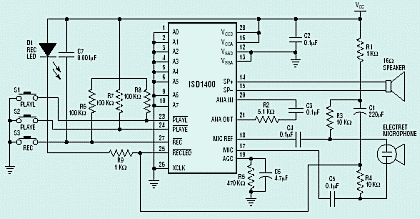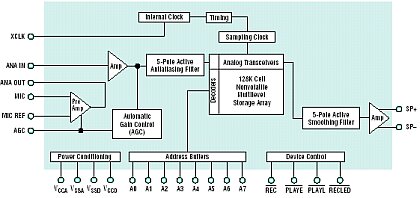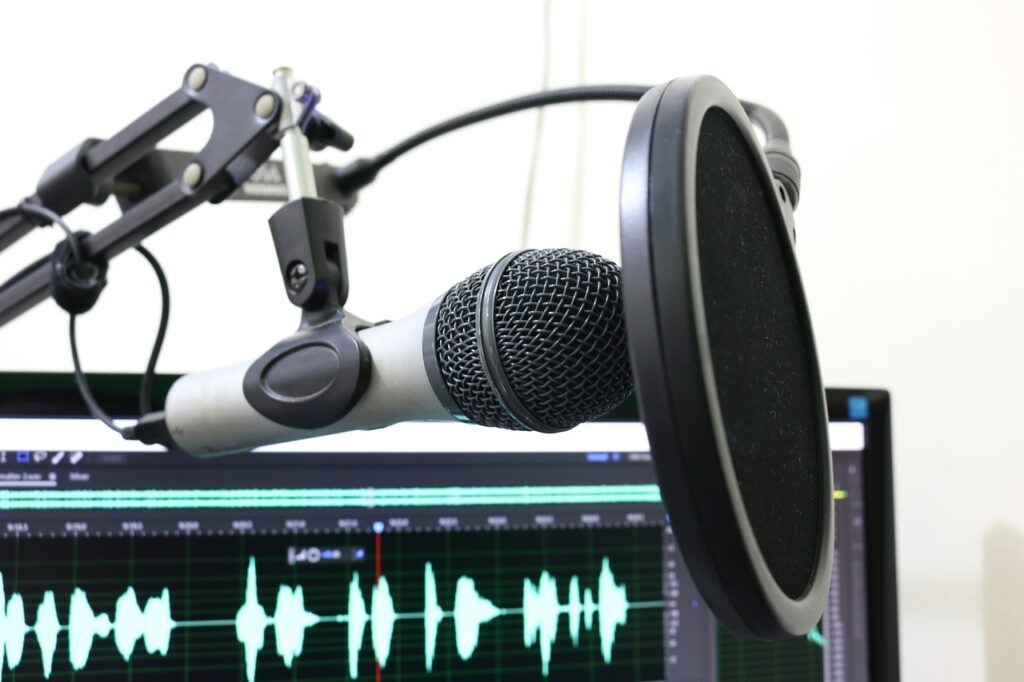V Rádiožurnáli 2/1998 popísali OK1VEY a OK1UKE elektronický opakovač s ISD obvodom podľa Bojana Debejaka S57BBD. Pre tých, ktorý spomínaný časopis nevlastnia by som odporúčal navštíviť web Jardu OK1VUP www.QSL.net/ok1vup, kde je schéma s Jardovými úpravami.

Opakovač, alebo voice keyer, je totiž veľmi užitočné zariadenie pre SSB contestmanov a je oň pomerne veľký záujem. Neuniklo ani mojej pozornosti a po získaní jedného obvodu ISD som obvod postavil. Funguje, ale v zázname je nepríjemný brum, ktorý nie a nie odstrániť. Na prosbu o pomoc cez sieť packet rádia zareagovala štvorica rádioamatérov – Jarda OK1VUP, Roman OK2CRC, Ivan OK1MMN a Luděk OK2IEN. Aj týmto sa im chcem poďakovať za cenné rady pri riešení tohto problému.
Najlepšie bude začať práve ich radami
Zdravim do zahranici..hi Pokud se jedna o to stejne co myslim , tj. zapojeni s ISDxxxx a mikroprocesorem.. atmel.. (zapojeni dle OK1UGA), tak ten brum neni zavada obvodu ISD, mne stacilo odpojit stineny kablik s elektretovym mikrofonem a v tu ranu brum nikde. Navic se jeho intenzita menila v zavislosti na ruznych uhlech.. jedina odpoved je ruseni atmelem ci 555kou co v zapojeni je.. Pokud vim tak pouzite ISD 2560 (8KHz/60 sec) funguje bezchybne…a samotne zadny brum do nahravaneho signalu nemicha.. S pozdravem, Roman, OK2CRC Ahoj DR OM, sam jsem postavil davac s ISD 1020 a 1016. Resil jsem stejny problem. Stravil jsem nad tim nekolik dni. Je potreba oddelit analogovou a digitalni zem. V praxi jsem to udelal tak, ze jsem pouzil stabilizaci 2x 7805 pro analogovou a digitalni cast zvlast. Vse beha bez nejmensich problemu k plne spokojenosti. Nemam tu pred sebou doporucene zapojeni vyrobce ale na schematu zapojeni IO s popisem vyvodu je videt kde tyto dve napajeni jsou. V doporucenem zapojeni jsou tyto dve VCC spojene, coz je samozrejme spatne. Opravuje to i dodatek vyrobce ISD v doporucenem zapojeni. Pokud by jsi sis stale nevedel rady mohl bych data sheet pohledat a rici ti presne ktere nohy to jsou. 73 Ludek OK2IEN DR OM. Neco podobneho jsem take vyrabel, ovsem vlastni kostrukce, „digitalni“ brum je zpusoben vzorkovanim a odstranit jej nelze, resil jsem to nakonec jazyckovym rele pripojenym na obvod voxu (tez vlastni konstrukce), ktere spinalo vystup pouze pokud byl na nem nejaky uzitecny signal maskujici brum, kupodivu to chodilo docela dobre a spinani nebylo v signalu slyset (myslim, ze se tam pripojoval nejaky odpor misto vystupu), problem byl spis s voxem, aby hned zabiral a mel tu spravnou casovou konstantu dobehu… Ted pouzivam zvukovou kartu. Tenhle VOX KEY jeste mam a obcas ho i pouziju. 73 ivan ok1mmn Ahoj, ja jsem se taky pred nedavnem pustil do stavby opakovace podle Ra 2/98 a se stejnym vysledkem – brum. neznam upravy o kterych pises, ale ja jsem to vyresil oddelenim zemi – analog a digital zvlast a to pomoci tlumivky. napajeni zustalo spolecne. na svych strankach na qsl.net mam novy obsah webu (zatim pod ok1vup.htm a ne pod index.htm, kde to v sekci technika popisuju. Podivej se na http://www.qsl.net/ok1vup/technika/opakovac/opakovac.htm, kde je schema jiz upraveneho zapojeni. Je pravda, ze v samotnem zaznamu se brum neobjevuje, ale jakmile to pripojim k TCVR, tak se trochu objevi (sle slabe) – na tom zatim pracuju, asi to bude chtit oddelit i napajeni. 73! Jarda OKVUP
Ako prvú som vyskúšal úpravu podľa SPRAT-u č.78 (jar 94). Podľa nej je na vývody ISD č.17 a 18 (mikrofónne vstupy) pripojený dynamický mikrofón. Ten by bol galvanicky oddelený od zeme. Výsledok však bol zlý…

Druhou modifikáciou bolo upravené pripojenie elektretového mikrofónu podľa AR-A 12/94. V tomto zapojení tiež nie je vývod mikrofónu pripojený priamo na zem. Výsledok tiež zlý…
Z informácií, ktoré som dostal som vyskúšal dve. Ako prvé úpravu od Jardu OK1VUP, ktorá vyžadovala len malé úpravy na plošnom spoji. Zlepšenie bolo badateľné, nie však dostatočné. Vyžadovalo by si to dlhodobejšie experimentovanie, hľadanie vhodnej tlmivky a pod.
Keď som skúšal Luďkovu úpravu s dvoma stabilizátormi, nepozornosťou som zapojil druhý stabilizátor tak, že bol napájaný z prvého, čiže piatimi voltmi. Na vývod č.28 ISD sa dostávalo zhruba 3,8V – no brum zmizol. Záznam bol však výrazne skreslený. V katalógovom liste nie je žiadna zmienka o rozsahu napájacieho napätia. Podľa článku v AR je to 4,5 až 6,5V.

Ďalším experimentovaním som dosiahol napokon stav, s ktorým som spokojný. Ponechal som jediný stabilizátor, pričom digitálnu čas ISD (vývod č.28) napájam cez germániovú diódu GA203. Je prispájkovaná zo spodnej strany plošného spoja pod obvodom, kde som preškrabol spoj. Po znížení napätia o pár desatín voltu je zhoršenie kvality záznamu minimálne, no po brume nie je ani stopy.
Okrem toho som urobil už iba jednu úpravu v obvode časovača. Rezistor R1 som zo 47k zmenšil na 22k a kondenzátor C2 z 2,2uF som zväčšil na 22uF. Takto sa medzera pred opakovaním záznamu dá nastaviť od 1,2 po 6,7 sekundy, čo sa mi zdá dostatočné.
Celkovo hodnotím zapojenie ako veľmi vydarené, plošný spoj je navrhnutý veľmi prehľadne a bez jedinej chyby. Môžem vrelo odporúčať aj ďalším po vykonaní drobných úprav.
Literatúra:
[1] Eletronický opakovač s ISD obvodem, Bojan Debeljak S57BBD, preklad OK1VEY a OK1UKE, Rádiožurnál 2/1998
[2] SPRAT č.74 (jar 1994), Analogue Solid stane speech recorder, Paul Lovell G3YMP
[3] Digitální audiopamäť G102, G103, Jindřich Tolg a Ing.Tomáš Tolg, Amatérske rádio A 12/1994
[4] http://www.qsl.net/ok1vup/technika/opakovac/opakovac.htm
[5] Katalód ISD14xx
